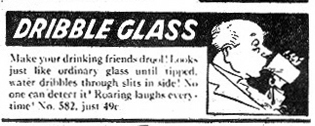Top Qs
Timeline
Chat
Perspective
Advertising in comic books
Comic book advertising From Wikipedia, the free encyclopedia
Remove ads
Comic book advertisements are a common feature in American comic books mainly from the 1940s onwards. As these advertisements were directed at young people, many made sensational claims,[1] and sold the products for a few dollars or less, to be sent to a post office box. Products offered included novelty items, toys, and self-improvement courses such as drawing and body building.

Remove ads
Companies
The Johnson Smith Company placed advertisements for gadgets and toys[2] that appeared on the back cover of many historically significant comic books, including Action Comics #1 (June 1938)[3] (the first appearance of the character Superman) and Detective Comics #27 (May 1939) (the first appearance of the character Batman).[citation needed]
Notable products offered
- Charles Atlas illustrated bodybuilding book
- Disappearing ink[4]
- Dribble glass
- Itching powder[5]
- Joy buzzer[4]
- Latex mask
- Potato gun[6]
- Sea-Monkeys[7]
- Sneezing powder
- Squirting flower[8]
- Stink bomb
- Whoopee cushion[9]
- X-ray specs[10]
The ads also included recruitment of youngsters to act as salespeople for products such as greeting cards and the national newspaper Grit.
See also
- Advertising to children
- Soren Sorensen Adams – a Danish-American inventor and manufacturer of novelty products, including the joy buzzer.
- Toy advertising
References
Further reading
External links
Wikiwand - on
Seamless Wikipedia browsing. On steroids.
Remove ads








